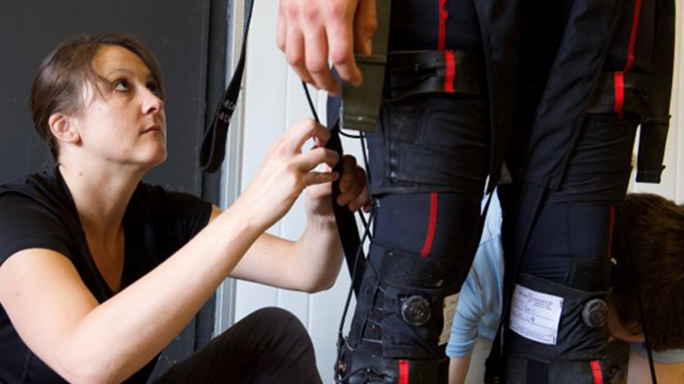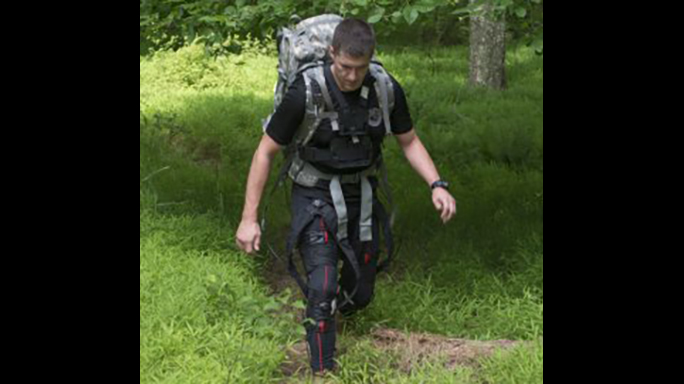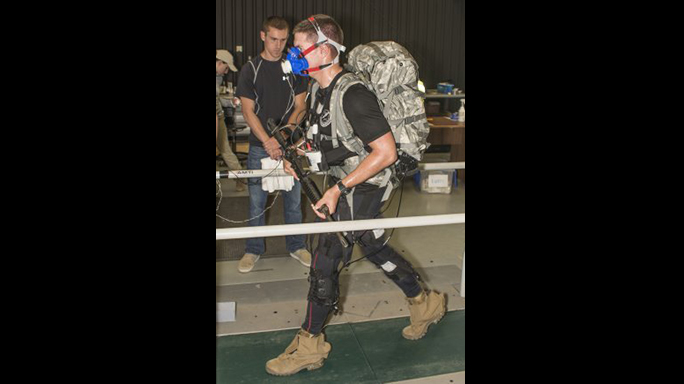The U.S. Army is in the process of testing a new prototype exoskeleton suit that would help soldiers carry heavier gear for longer distances and boost mental alertness.
Complete with pulleys and gears which mitigate and prevent musculoskeletal injuries typically experienced in the field, the U.S. Army Research Laboratory has been testing different variants of the suit for over three years at the Soldier Performance and Equipment Advanced Research, or SPEAR, facility at Aberdeen Proving Ground, the Army said in a press release.
“We’ve been primarily focusing on the physical benefits of these types of suits, but we’re also interested in the cognitive benefits,” said ARL researcher Dr. Angela Boynton. “We’re hoping that by reducing the physical burden, that they also have the ability to put more energy into other types of tasks that involve cognitive or perceptual workload.”
Advertisement — Continue Reading Below
- RELATED STORY: LUKE Arms – DARPA Delivers Bionic Arms for Military Amputees
The exoskeleton suit enjoyed a soft demonstration in June with the U.S. Army Natick Soldier Research, Development and Engineering Center; the Maneuver Center of Excellence; the Army Capabilities Integration Center and the Military Operational Medicine Research Program.
The project falls under DARPA’s Warrior Web program, which is now coming to an end, but researchers are still optimistic they’ll find “collaborators” to help build on the progress they’ve already made.
“In the longer term, the systems have benefits to be integrated into larger Soldier systems and can be integrated with other capabilities to provide a marked advantage for our Soldiers and our warfighters in the future,” said Maj. Christopher Orlowski, DARPA’s Warrior Web program manager. “I think it will take at least another five to 10 years to be ready for the infantry Soldier.”
Advertisement — Continue Reading Below
Among the attendees at the demonstration, held in conjunction with ongoing testing at the Army Research Laboratory, was a team of researchers from Harvard’s Wyss Institute led by Dr. Conor Walsh, associate professor of engineering and applied sciences at the Harvard biodesign lab. Walsh and his team have been testing prototypes on soldiers since 2014, the Army said.
“The meeting was a good opportunity for our team to summarize the progress we have made as part of the DARPA Warrior Web Program to other Army stakeholders and get their feedback on how they see the technology and what further work remains to continue to optimize it,” Walsh said.
Walsh added that the latest exoskeleton suit tested at ARL is more user-friendly compared to previous prototypes, offering improved functional apparel attachments to the body, control systems that adapt to each end user, and quiet and compact actuation systems.
Advertisement — Continue Reading Below
Edwin “Eddie” Davis, director of the Maneuver Battle Lab, Capabilities Development Integration Directorate Maneuver Center of Excellence, said in the Army press release that he liked what he saw, stressing that that soldiers should have a say in the equipment they use in combat.
“Warrior Web is a perfect example where engineers and Soldiers work together ‘early and often’ to develop a capability that might be useful for the future,” Davis said. “It also helps speed up the technology transition and program acquisition. Soldier feedback will help frame the Warrior Web Program outcomes and future Army investment.”
All parties involved have praised the SPEAR facility as being instrumental during the testing process.
Advertisement — Continue Reading Below
“We have an indoor lab capability where we can instrument up the Soldiers and keep them in an environment where you can just get pure data on things like treadmills, motion capture and be able to analyze everything in the lab,” stated Henry Girolamo, NSRDEC program manager for the Warrior Web project. “You can take them out on a three-mile course where it’s more aligned with the environments in which they would be working. We’ve got the best of both worlds.”
The same group of soldiers were tested in April and June, with and without the suit, for data-gathering purposes.
“If you reduce the physical burden on somebody, there may be some benefits additionally to the amount of attention they can pay to their situational awareness,” Boynton said.
Advertisement — Continue Reading Below
Now, it’s just a question of finding funding to continue the project.
“I see it as a solution-focused suite of technologies that support a wide array of Soldier issues that we are having to deal with right now,” Girolamo said. “We need to iterate the technology a little bit further along to make sure we can actually do that and I know we can. We just need the funding and time to do that.”
Advertisement — Continue Reading Below
























